Common Types of Ostomies: Colostomy, Ileostomy, and Urostomy
Colostomy
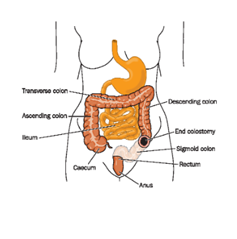 A colostomy is a surgically created opening in the abdomen that creates a passageway in which a piece of the colon (large intestine) is brought to an outside opening in the skin called a stoma or ostomy, usually on the left side of your lower abdomen. This allows digested food to pass into an external pouch system. Having a colostomy should not affect your ability to eat food and one’s bowel movement patterns will depend on how much of the colon was removed and pre-surgery patterns.
A colostomy is a surgically created opening in the abdomen that creates a passageway in which a piece of the colon (large intestine) is brought to an outside opening in the skin called a stoma or ostomy, usually on the left side of your lower abdomen. This allows digested food to pass into an external pouch system. Having a colostomy should not affect your ability to eat food and one’s bowel movement patterns will depend on how much of the colon was removed and pre-surgery patterns.
People of all ages require a colostomy for many reasons due to a disease process such as cancer or Chron’s disease, damage through injury or accidents, or congenital problems. Some colostomies are temporary, and some are permanent.
Temporary colostomy: May be required to give a portion of the bowel a chance to rest and heal. When healing has occurred, the colostomy can be reversed, and normal bowel function restored.
Permanent colostomy: May be required when a disease affects the end part of the colon or rectum.
Most people who have colostomies continue to have normal, healthy, and productive lives. They work, play sports, have children, and do the things that most people do.
Ascending colostomy
- Created out of the ascending colon.
- Bowel movements are loose, pasty, or watery.
- Stoma is usually located on the right side of the abdomen.
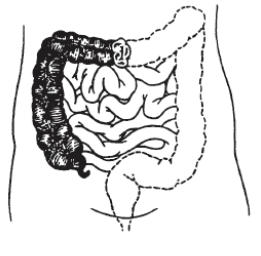
Descending colostomy
- Created out of the descending colon.
- Bowel movements are usually soft.
- Stoma is usually located on the left side of the abdomen.
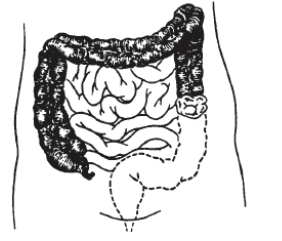
Sigmoid colostomy
- Created out of the last part of the colon.
- Bowel movements can be soft or firm.
- Stoma is usually located on the left side of the abdomen.
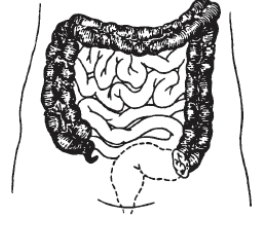
Loop ostomy
- Created out of any part of the small intestine or colon.
- There are 2 openings in the stoma instead of 1. Many times, only 1 opening can be seen. This type of ostomy is often temporary.
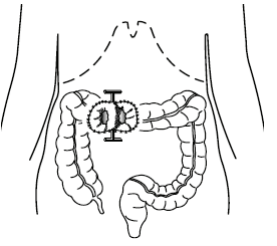
Ileostomy
An Ileostomy is a surgically created opening in the abdomen in which a piece of the ileum (lowest part of the small intestine) is brought outside the abdominal wall sewn into place --- typically on the right side---to create a stoma through which digested food passes into an external pouching system.
With an ileostomy there is no control over the gas and stool coming out of the opening, (stoma or ostomy). A bag or pouch worn over this opening (attached by adhesive) collects all the gas and stool. Usually, people who have an ileostomy have had their colons (large intestines) removed because of Ulcerative Colitis or Crohn’s disease.
Ileostomies can be temporary or permanent.
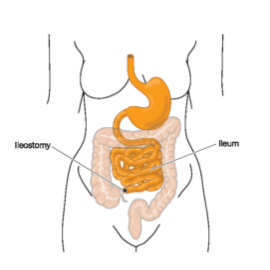 Temporary ileostomy: May be required when a surgical site lower in the digestive tract needs time to heal. Examples include colorectal cancer surgeries, diverticulitis surgery, j-pouch surgery for ulcerative colitis, or familial polyposis. A temporary ileostomy is usually constructed with a “loop” stoma.
Temporary ileostomy: May be required when a surgical site lower in the digestive tract needs time to heal. Examples include colorectal cancer surgeries, diverticulitis surgery, j-pouch surgery for ulcerative colitis, or familial polyposis. A temporary ileostomy is usually constructed with a “loop” stoma.
Permanent ileostomy: May be required when the large intestine is removed and reconnection to the anus isn’t feasible. Possible causes include Crohn’s disease, some cancers, colonic dysmotility, and some cases of ulcerative colitis or familial polyposis. A permanent ileostomy is usually constructed with an “end” stoma.
Urostomy
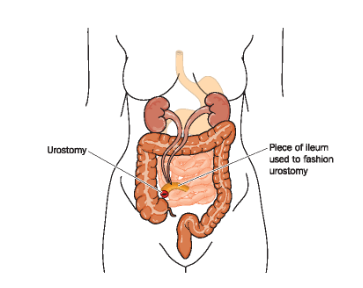 A Urostomy is a surgically created opening in the abdomen wall where a small piece of the intestine (ileum) allows urine to pass through. The ureter, or the tube that carries urine from the kidneys to the bladder, is diverted through this piece of small intestine. The stoma opening allows urine to flow out of your body and into an ostomy pouch. A urostomy may be performed when the bladder is either not functioning or must be removed. There are several different types of surgeries, but the most common are ileal conduit and colonic conduit.
A Urostomy is a surgically created opening in the abdomen wall where a small piece of the intestine (ileum) allows urine to pass through. The ureter, or the tube that carries urine from the kidneys to the bladder, is diverted through this piece of small intestine. The stoma opening allows urine to flow out of your body and into an ostomy pouch. A urostomy may be performed when the bladder is either not functioning or must be removed. There are several different types of surgeries, but the most common are ileal conduit and colonic conduit.
People of all ages require urostomy for many reasons due to bladder cancer, spinal cord injuries, a malfunction such as chronic infection of the bladder, or birth defects such as spina bifida. Urostomies are not reversible.

